Abstract
In addition to the common stable and metastable phases in titanium alloys, the face-centered cubic phase was recently observed under various conditions; however, its formation remains largely unclarified. In this work, the effect of nonmetallic interstitial atoms O, N, C and B on the formation of the face-centered cubic phase of titanium was investigated with the density functional theory. The results indicate that the occupancy of O, N, C and B on the octahedral interstitial sites reduces the energy gap between the hexagonal-close-packed (HCP) and face-centered cubic (FCC) phases, thus assisting the formation of FCC-Ti under elevated temperature or plastic deformation. Such a gap further decreases with the increase in the interstitial content, which is consistent with the experimental observation of FCC-Ti under high interstitial content. The relative stability of the interstitial-containing HCP-Ti and FCC-Ti was studied against the physical and chemical origins, e.g., the lattice distortion and the electronic bonding. Interstitial O, N, C and B also reduce the stacking fault energy, thus further benefiting the formation of FCC-Ti.
1. Introduction
Because of their excellent comprehensive mechanical properties, preeminent corrosion resistance and biological compatibility, titanium alloys are widely used in aerospace, automobile manufacturing, medical equipment [1,2,3], etc. Under ambient conditions, pure titanium stabilizes at the hexagonal-close-packed (HCP) α phase, which transforms into the body-centered cubic structure (BCC) β phase above the β transus temperature. Previous investigations also suggest the existence of the metastable face-centered cubic (FCC) phase in various Ti alloys in film or bulk samples [4,5,6,7,8,9,10,11,12,13,14,15], as well as in Zr alloys [16,17], which may also significantly influence the microstructure evolution like other metastable phases, e.g., the hexagonal ω and α’ phases and the tetragonal α” phase [18,19,20,21,22]. However, the formation of FCC-Ti remains largely unclarified, and thus hinders further microstructure control.
The addition of alloying elements either alters the phase β-α transus temperature or introduce other phases, e.g., hexagonal α2-Ti3Al, whereas the FCC phase is rarely observed. It was believed that the FCC phase was only a hydride formed by hydrogen contamination during sample preparation [12]. However, in several in situ transmission electron microscope (TEM) observations [8,11,13], the stable FCC phase was found at a high temperature far beyond the decomposition temperature of TiHx (x ≥ 1), where the appearance of FCC-Ti was attributed to the interstitial oxygen [13]. The FCC phase was also found in titanium alloy samples after ball milling, rolling, explosive impact and other mechanical deformation [6,7,14,23]. In particular, the contribution of interstitial carbon to the formation of FCC-Ti in Ti37Nb28Mo28-C7 alloy under ball milling was proven through the combination of a simulation and experiment [14]. Despite the confirmation of the FCC phase in Ti alloys, its formation mechanism remains unclear. Two types of orientation relationships between HCP-Ti and FCC-Ti have been identified, i.e., P-type ( and ) and B-type ( and ). Atomic-scale calculations have been performed to analyze the formation conditions and mechanism of FCC-Ti under mechanical deformation [24,25,26], but the results were insufficient to explain the appearance of FCC-Ti in high-temperature in situ TEM observations [13].
Given the fact that interstitial atoms have been proven to have influence on the crystal structure of high-entropy alloys [27] and the results of the increase in interstitial atoms in the previous in situ heating experiments of titanium alloys [13], the present work focuses on the effect of nonmetallic interstitial elements O, N, C and B on the phase transition from HCP-Ti to FCC-Ti based on the density functional theory. Firstly, the stable interstitial sites in HCP-Ti and FCC-Ti and the relationship between the formation energy and the interstitial content were investigated. Secondly, the influence of interstitial elements on the relative stability of HCP-Ti and FCC-Ti was rationalized and attributed to the difference in the electronic structure and lattice distortion by the interstitial solutes. Finally, the possible formation mechanism of FCC-Ti was discussed by investigating the influence of the interstitial atoms on the generalized stacking fault energy of HCP-Ti. The results of the present work will shed light on the impact of phase transformation on the thermal and mechanical processing and additive manufacturing of titanium alloys for better properties.
2. Method
All calculations were based on density functional theory using VASP (Vienna Ab-inito Simulation Package 5.4.4, Hafner Research Group, University of Vienna) [28]. The interaction between nucleus and electron was described by projecting plane waves, and the generalized gradient approximation function in the form of PBE was used to estimate the exchange correlation energy. The plane wave cutoff energy was set to 450 eV, the energy tolerance for the electronic minimization was set as 10−6 eV/atom, and the Hellman–Feynman force tolerance was set as 0.01 eV/Å.
To verify the accuracy of the calculation parameter setting, we compared the results of lattice relaxation with the literature. The results are shown in Table 1.

Table 1.
Comparison of DFT results.
In the calculation of the interstitial formation energy in HCP-Ti and FCC-Ti, the unit cells oriented as , , and , , were employed. One single interstitial atom was added in the HCP-Ti boxes expanded as , , and , while in the FCC-Ti boxes, it was expanded as , , and . As such, the atomic fractions of 1.54 at.%, 3.03 at.%, 5.88 at.% and 11.11 at.% were achieved, with the corresponding mass fraction of 0.52~4.01 wt.% (O), 0.45~3.53 wt.% (N), 0.39~3.04 wt.% (C) and 0.35~2.75 wt.% (B). The vaspkit [32] was used to generate a k-point mesh with the same precision (fine = 0.02) centered on the Gamma point. For the geometry optimizations and elastic constant calculations, the supercell shape and all atoms are allowed to relax.
In the calculation of the generalized stacking fault energy of α-Ti, the unit cells oriented as 0], 00], , boxes expanded as , each cell containing 56 titanium atoms and 1 interstitial atom, as well as a vacuum layer of 20 Å [33], were employed. The Г-point-centered Monkhorst–Pack grids [34] of 6 × 7 × 1 were used. The upper half box slid along <110> and <100> relative to the lower half, while the interstitial atoms were placed in the octahedral interstitials adjacent to the sliding plane. A full periodic boundary was employed with atoms only allowed to relax in the z direction.
3. Results and Discussion
3.1. Stable Interstitial Site
Single B, C, N and O atoms are placed at various interstitial sites to determine the stable interstitial sites in HCP-Ti and FCC-Ti. The interstitial formation energy is defined as [35,36]:
where N is the number of atoms in the Ti matrix, is the total energy of the system with N Ti atoms and an interstitial atom M (M = B, C, N or O), is the energy per atom in pure HCP-Ti or FCC-Ti, and is the energy per atom of pure element M (−6.679, −9.22, −8.336 and −4.948 eV/atom for B, C, N and O, respectively, from the Material Project database [37]). Both octahedral (Octa) and tetrahedral (Tetra) interstitial sites are considered in HCP-Ti and in FCC-Ti, as well as the plane-centered (PC) and bond-centered (BC) sites in FCC-Ti (Figure 1).
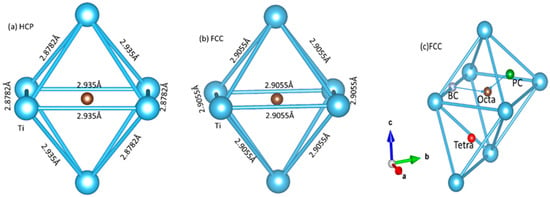
Figure 1.
(a,b) Schematic diagrams of the octahedral interstitial sites in HCP-Ti and FCC-Ti, respectively. (c) Interstitial sites in FCC-Ti.
As shown in Figure 2a, in HCP-Ti, the atoms in the initial tetrahedral position enter the nearest hexahedral position after relaxation, while the octahedral gap is stable and the formation energy is the lowest. This is consistent with previous investigations, which indicated that the octahedral interstitial is stable in α-Ti, and it is difficult for interstitial atoms to exist in the tetrahedral interstitial site [35,38,39]. In FCC-Ti, interstitial atoms are further sited at the face-centered and bond-centered sites, as shown in Figure 1c. However, interstitial atoms in BC and PC interstitial sites automatically move to the nearest octahedral position after relaxation. The present result indicates that in HCP-Ti and FCC-Ti, the most stable interstitial site is the octahedral site. This is also consistent with previous investigations, which indicated that the stable interstice is the octahedral site [40,41]; however, unlike α-Ti, its atoms in the tetrahedral interstice do not escape under relaxation. Interstitials are exclusively placed in the octahedral sites in the following calculations. Figure 2b shows that when the interstitial atoms are located in a stable octahedral interstitial, the interstitial atom formation energy of the four kinds of interstitial atoms changes slightly with the change in content. However, all interstitial atoms still prefer to stay in the octahedral interstitial of FCC-Ti; that is, the stable structure composed of interstitial atoms and interstitial vertex atoms (Ti) is the octahedral structure in FCC-Ti.

Figure 2.
(a) The formation energy with different interstitials (data points represented by green stars are from Ref. [35]); (b) the relationship between the formation energy of interstitial atoms and the content of interstitial atoms in two structures when interstitial atoms are in octahedral interstitial spaces.
3.2. Stability against Interstitial Content
According to the method of Jiang et al. [14], the interstitial effect is further studied against the interstitial content and the B, C, N and O species. In addition to the formation energy employed in Equation (1), we further define the average cohesive energy as follows for comparison between different interstitial species:
where is the total number of atoms, and the modified values Emh and MEmi of titanium atoms and interstitial atoms were calculated according to the VASP manual. Then, the relative stability of HCP-Ti and FCC-Ti containing the same number of interstitials is determined by the difference in their cohesive energies:
Figure 3a shows the effect of interstitial atoms on the average cohesive energy. Consistent with the results in Figure 2a, B atoms are not easy to be solubilized in titanium, while the other three types of atoms can increase the stability of the two structures, but the stability of FCC-Ti is increased more significantly. As shown in the Figure 3b, is closely relevant to both the interstitial content and specie within the range investigated. The leftmost point indicates the cohesive energy difference in HCP-Ti and FCC-Ti without interstitial, i.e., . = 58 meV/atom. As the interstitial content increases, exclusively decrease, indicating the enhanced stability of FCC-Ti relative to HCP-Ti. At the largest interstitial content of 11 at.%, amounts to 20, 20, 30 and 43 meV/atom for B, C, N and O, respectively, with reductions of 38, 38, 28 and 15 meV/atom.
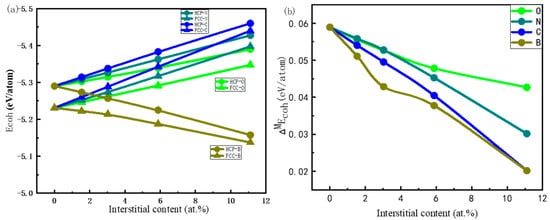
Figure 3.
(a) The average cohesive energy () varies with the content; (b) the relation between the per-atom cohesive energies and the interstitial content (M represents B, C, N or O).
Despite the larger energy decrease with interstitial B, C and N compared with O, FCC-Ti is seldom observed in Ti-B, Ti-C and Ti-N systems, as intermetallic compounds TiB, Ti2N and TiC [42,43,44] are extremely easy to form with significantly smaller solid solubility compared with O, especially at a high temperature. Nevertheless, with C addition, FCC-Ti was observed in a BCC-type Ti37Nb28Mo28-C7 alloy [14]. It is worth noting that interstitial atoms may have a more pronounced effect on in situ heating. In the experiment where FCC-Ti formation was observed by in situ heating, the initial sample was Ti-0.1 wt% O. During heating, the oxygen content in the sample increased from 0.05 at.% to 7.77 at.%, and the carbon content increased from 0.03 at.% to 1.44 at.% [13]. It can be seen from the calculation that the increase in the content of C and O has an important influence on the reduction in the phase transition energy barrier, so it is not difficult to understand why the formation of FCC-Ti is easier to be observed in these in situ heating experiments [8,11,13].
3.3. Electronic Structure with Interstitials
To understand the above influence of nonmetallic interstitials on the phase stability, the electron density of states (DOSs) of HCP-Ti and FCC-Ti with interstitial B, C, N and O were calculated at the content of 11.11 at.% regarding the 3s, 3p, 4s and 3d electrons of Ti, as well as the 2s and 2p electrons of the interstitial atoms [39]. The total DOS and projected DOS are shown in Figure 4. For O and N, mainly the 2p orbitals interact with the 3d orbitals of Ti, while for C and B, both the 2p and 2s orbitals interact with the 3d orbitals of Ti. The electron density states of the orbital interaction between solute atoms and interstitial atoms in FCC-Ti are more dispersed in energy levels compared with those in HCP-Ti, indicating that Ti atoms and the interstitial atoms are more likely to form covalent bonds in FCC-Ti. In addition, it can be seen from Figure 4 that the orbital interaction between interstitial atoms and titanium atoms will shift to a lower energy level after more covalent bonding. On the other hand, the results of integral crystal orbital Hamilton populations (ICOHP) [45] analysis also prove that interstitial atoms exhibit stronger bonding with Ti atoms in FCC-Ti (Table 2).
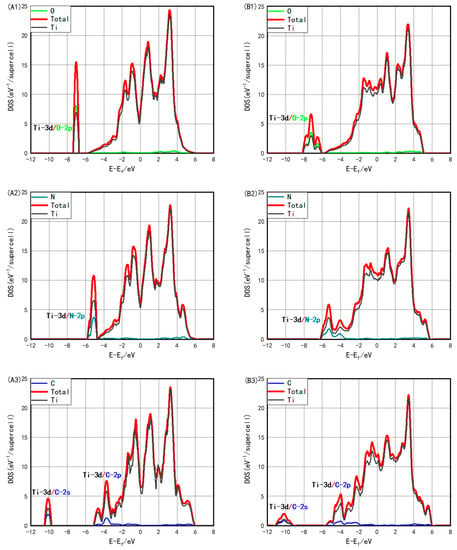
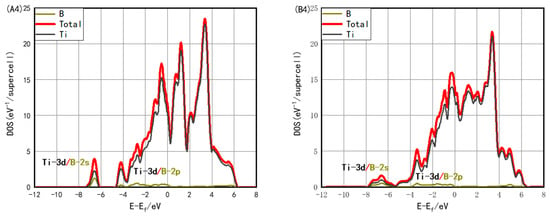
Figure 4.
Total and projected density of states (PDOS) in HCP-Ti (A1–A4) and FCC-Ti (B1–B4) with interstitial B, C, N and O.

Table 2.
Integral of crystal orbital Hamilton populations analysis.
3.4. Influencing Factors of HCP-FCC Phase Transition
Since the relative stability of the interstitial-containing HCP-Ti and FCC-Ti is relevant to the interstitial species, we pursue the study from the physical and chemical aspects, which are determined by the lattice distortion and the electronic structure, respectively, to further clarify the atomic-scale influencing parameters of the HCP-FCC phase transition in Ti alloys. The solution of interstitial atoms causes the energy of the two systems to be close, and this contribution is represented by ΔEtotal.
where and are the energy of a pure titanium perfect cell with an HCP structure and FCC structure, respectively. and are the energy of the crystal cell containing interstitial atom M (M = B, C, N, O; one interstitial atom was solidly dissolved in these systems, and the content was 11.11 at.%.) with an HCP structure and FCC structure, respectively. After the solid solution of interstitial atoms, the energy of the two systems is close because of the difference in the physical and chemical energy introduced by interstitial atoms in the two systems.
△Etotal = △Ephy + △Echem
We delete the interstitial atoms in these systems after solid solution relaxation and perform a single-point energy calculation for the system with lattice distortion. The energy obtained is denoted as and , respectively.
Finally, as shown in Figure 5, the reduction in the phase transition energy barrier is mainly caused by the difference in the chemical energy introduced by interstitial atoms in the solid solution of the two systems. For example, the C atom reduces the energy barrier of the two systems by 0.286 eV, in which chemical energy contributes −0.339 eV and physical energy contributes 0.053 eV.
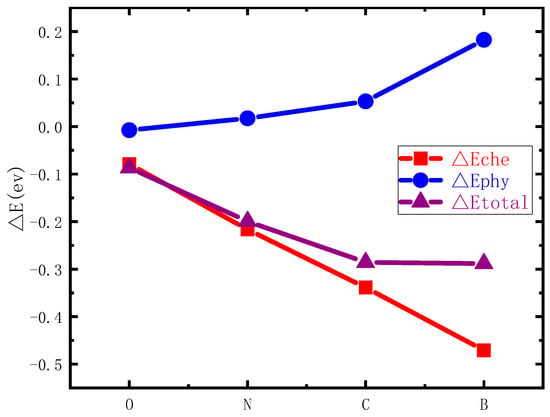
Figure 5.
Contribution of interstitial atoms to the reduction of energy barrier in two systems.
To determine electronic bonding and the lattice distortion, Pauling’s electronegativity (χ) [46], the Bader charge (Q) [39,47], the atomic radius (R) [48] and the average distortion (δ), which significantly vary among the interstitial elements, are used. For convenience, we define the relative values as Δχ: the difference in Pauling’s electronegativity between the interstitial atoms and Ti; ΔQ: the difference in the Bader charges acquired by the interstitial atoms between FCC-Ti and HCP-Ti; ΔR: the difference in the atomic radii between the interstitial atoms and Ti; and Δδ: the difference in the average distortion between interstitial-containing HCP-Ti and FCC-Ti. Figure 6 shows the values of Δχ, ΔQ, ΔR and Δδ of interstitial atoms O, N, C and B, where Δχ and Δδ decrease, while ΔQ and ΔR increase in the order of O, N, C, B. Δχ and ΔQ are strongly inversely intercorrelated, while ΔR and Δδ weakly inversely intercorrelate.
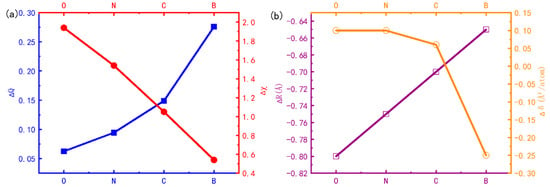
Figure 6.
(a) The relative Pauling’s electronegativity (Δχ), the relative Bader charge (ΔQ); (b) The relative atomic radius (ΔR) and the relative average distortion (Δδ) of interstitial atoms B, C, N and O.
Lattice distortion is defined as
where Nh is the number of titanium atoms in a system, and vs and Ve are the volume of crystal cells before and after solid solution distortion, respectively. Accordingly, we define δ to reflect the difference in cell aberration caused by interstitial atoms in the two crystal structures.
Hence, the relative phase stability, , can exist. Figure 7 shows the dependence of relative phase stability, , on the relative Pauling’s electronegativity (Δχ), the relative Bader charge (ΔQ), the relative atomic radius (ΔR) and the relative average distortion (Δδ) of the interstitial atoms O, N, C and B at the content of 11.11 at.%.
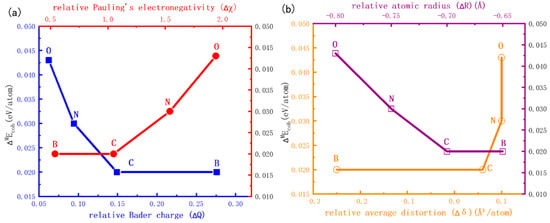
Figure 7.
(a) The dependence of relative phase stability, , on Pauling’s electronegativity, the difference in Bader charge; (b) The atomic radius and the difference in average distortion of the interstitial atoms O, N, C and B at the content of 11.11 at.%.
For O, N and C atoms, the difference in solution distortion between the two systems is small. The relative stability of the interstitial-containing HCP-Ti and FCC-Ti is more relevant to electronic bonding than the local lattice distortion. A large Δχ favors ionic bonding between atoms; hence, the bonding covalency of the intestinal atom with the Ti atoms decreases in the order of C, N and O. Since Δχ and ΔQ are inversely intercorrelated, the increase in Δχ and the decrease in ΔQ are relevant to (Figure 7a). On the other hand, is weakly dependent on ΔR and almost independent on Δδ. For these systems containing B atoms, the difference in solution distortion is not negligible. On the one hand, a B atom has stronger bond cooperation with Ti atoms in the FCC-Ti system, which reduces the energy difference between the two systems; on the other hand, it causes greater solid solution distortion in the FCC-Ti system (Figure 7b), which increases . Therefore, it has a larger ΔQ value but contributes almost as much to phase stability as carbon (Figure 5 and Figure 7b).
In this study, the value of is affected by two aspects. One is the difference in chemical energy caused by different bonding states of interstitial atoms in the two systems. The other is the difference in strain energy introduced by interstitial atoms in different systems. A comprehensive comparison of the four interstitial atoms shows that charge transfer and lattice distortion affect the relative phase stability of the two systems, and charge transfer plays a major role (Figure 5 and Figure 8). Of course, we should not ignore that the premise we give is the formation of an interstitial solid solution. For example, a B atom should not be considered as an atom prone to FCC-Ti formation due to its large interstitial atomic formation energy.
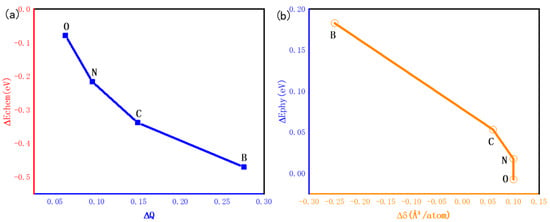
Figure 8.
(a) The relationship between the difference in charge transfer amount and the contribution from chemical energy; (b) the relationship between the difference in solid solution distortion and the contribution from physical energy.
3.5. Stacking Fault Energy
The generalized stacking fault energy is defined as follows [33,49,50]:
where Er is the system energy after the slide of the upper part relative to the lower part at a given distance, E0 is the initial system energy, and S is the area of the slip surface.
The influence of the interstitial atoms on the slip of HCP-Ti along the <110> and <100> directions is shown in Figure 9. Without interstitial atoms in the system, the intrinsic stacking fault energy () is 309 mJ/m2, while the unstable stacking fault energy of pure HCP-Ti along <110> and <100> ( and ) are 470 mJ/m2 and 411 mJ/m2, respectively. This is consistent with previous results on i.e., 287 mJ/m2 in Ref. [51], 307 mJ/m2 in Ref. [33] and 310 mJ/m2 in Ref. [52]. With interstitial atoms O, N, C and B, reduces to 269 mJ/m2, 258 mJ/m2, 257 mJ/m2 and 200 mJ/m2, respectively, whereas increases to 567 mJ/m2, 556 mJ/m2, 534 mJ/m2 and 492 mJ/m2, respectively. In addition, B significantly reduces , the other three atoms have no obvious effect on .The increase in / and the decrease in favor the following dislocation dissociation [29]:
which further facilitates the formation of FCC-Ti through the slip of Shockley partial dislocations [14].
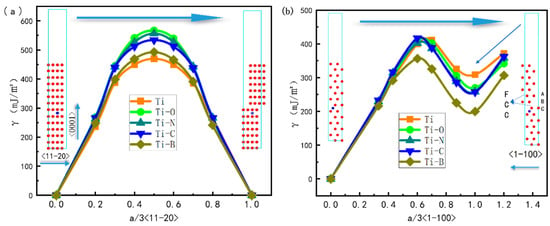
Figure 9.
(a) Generalized layer fault energy of α-Ti along direction <110>; (b) generalized layer fault energy of α-Ti along direction <1 00>.
4. Conclusions
In the present work, the effect of nonmetallic interstitial atoms B, C, N and O on the hexagonal-close-packed (HCP) to face-centered cubic (FCC) phase transition of titanium was investigated with the density functional theory. The following conclusions can be drawn:
- In both HCP-Ti and FCC-Ti, the nonmetallic atoms B, C, N and O favor the octahedral interstitial site rather than the tetrahedral site. The octahedral B, C, N and O interstitials decrease the energy gap between FCC-Ti and HCP-Ti, and the gap further decreases with the increase in the interstitial content.
- The relative stability of the interstitial-containing HCP-Ti and FCC-Ti is strongly relevant to the electronic structure, while it is weakly relevant to the lattice distortion. The relative stability of FCC-Ti decreases with the relative Pauling’s electronegativity, while it increases with the relative Bader charge.
- The existence of interstitial atoms reduces the intrinsic stacking fault energy of HCP-Ti, which is conducive to the decomposition of perfect dislocation into partial dislocations and is further beneficial to the formation of FCC-Ti.
Author Contributions
Conceptualization, H.W. and Y.Y.; methodology, M.Y., J.H. and S.C.; validation, R.L., S.L., F.Z., A.F., Q.H. and A.H.; formal analysis, all authors; writing-original draft preparation, M.Y. and H.W.; writing-review and editing, all authors; project administration, H.W., Y.Y. and A.H. All authors have read and agreed to the published version of the manuscript.
Funding
The authors acknowledge the financial support of the Shanghai Engineering Research Center of High-Performance Medical Device Materials (20DZ2255500), the Key-Area Research and Development Program of GuangDong Province (2019B010941001), the Major Special Science and Technology Project of Yunnan Province (202002AB080001-3), the National Natural Science Foundation of China (91960202) and (52001307), the Key Research Program of Frontier Sciences, Chinese Academy of Sciences (QYZDJ-SSW-JSC031), the State Key Laboratory of Light Alloy Casting Technology for High-end Equipment (LACT-007), the Shenyang Talents program (RC200230) and the Opening Project of National Key Laboratory of Shock Wave and Detonation Physics (2022JCJQLB05702).
Institutional Review Board Statement
Not applicable.
Informed Consent Statement
Not applicable.
Data Availability Statement
The data presented in this study are available on request from the corresponding author.
Conflicts of Interest
The authors declare no conflict of interest.
References
- Hama, T.; Kobuki, A.; Takuda, H. Crystal-plasticity finite-element analysis of anisotropic deformation behavior in a commercially pure titanium Grade 1 sheet. Int. J. Plast. 2017, 91, 77–108. [Google Scholar] [CrossRef]
- Kazemi, M.; Ahangarani, S.; Esmailian, M.; Shanaghi, A. Investigation on the corrosion behavior and biocompatibility of Ti-6Al-4V implant coated with HA/TiN dual layer for medical applications. Surf. Coat. Technol. 2020, 397, 126044. [Google Scholar] [CrossRef]
- Davids, W.J.; Chen, H.; Nomoto, K.; Wang, H.; Babu, S.; Primig, S.; Liao, X.; Breen, A.; Ringer, S.P. Phase transformation pathways in Ti-6Al-4V manufactured via electron beam powder bed fusion. Acta Mater. 2021, 215, 117131. [Google Scholar] [CrossRef]
- Grünbaum, E.; Schwarz, R. Epitaxial Growth of Titanium Films on Mica. J. Appl. Phys. 1969, 40, 3364–3369. [Google Scholar] [CrossRef]
- Bonevich, D.v.H.J.; Josell, D. Face-centered-cubic titanium: An artifact in titanium/aluminum multilayers. J. Mater. Res. Technol. 1999, 14, 1977–1981. [Google Scholar] [CrossRef]
- Prasanthi, T.N.; Sudha, C.; Ravikirana; Saroja, S. Formation and reversion of metastable fcc phase in a Ti–5Ta–2Nb explosive clad. Mater. Charact. 2016, 116, 24–32. [Google Scholar] [CrossRef]
- Wu, H.C.; Kumar, A.; Wang, J.; Bi, X.F.; Tomé, C.N.; Zhang, Z.; Mao, S.X. Rolling-induced Face Centered Cubic Titanium in Hexagonal Close Packed Titanium at Room Temperature. Sci. Rep. 2016, 6, 24370. [Google Scholar] [CrossRef]
- Yu, Q.; Kacher, J.; Gammer, C.; Traylor, R.; Samanta, A.; Yang, Z.; Minor, A.M. In situ TEM observation of FCC Ti formation at elevated temperatures. Scr. Mater. 2017, 140, 9–12. [Google Scholar] [CrossRef]
- Chen, C.; Qian, S.; Wang, S.; Niu, L.; Liu, R.; Liao, B.; Zhong, Z.; Lu, P.; Li, P.; Cao, L.; et al. The microstructure and formation mechanism of face-centered cubic Ti in commercial pure Ti foils during tensile deformation at room temperature. Mater. Charact. 2018, 136, 257–263. [Google Scholar] [CrossRef]
- Han, G.; Lu, X.; Xia, Q.; Lei, B.; Yan, Y.; Shang, C. Face-centered-cubic titanium—A new crystal structure of Ti in a Ti-8Mo-6Fe alloy. J. Alloy. Compd. 2018, 748, 943–952. [Google Scholar] [CrossRef]
- Ma, X.; Guo, X.; Fu, M.; Qiao, Y. In-situ TEM observation of hcp-Ti to fcc-Ti phase transformation in Nb-Ti-Si based alloys. Mater. Charact. 2018, 142, 332–339. [Google Scholar] [CrossRef]
- Chang, Y.; Zhang, S.; Liebscher, C.H.; Dye, D.; Ponge, D.; Scheu, C.; Dehm, G.; Raabe, D.; Gault, B.; Lu, W. Could face-centered cubic titanium in cold-rolled commercially-pure titanium only be a Ti-hydride? Scr. Mater. 2020, 178, 39–43. [Google Scholar] [CrossRef]
- Traylor, R.; Zhang, R.; Kacher, J.; Douglas, J.O.; Bagot, P.A.; Minor, A.M. Impurity and texture driven HCP-to-FCC transformations in Ti-X thin films during in situ TEM annealing and FIB milling. Acta Mater. 2020, 184, 199–210. [Google Scholar] [CrossRef]
- Jiang, S.; Huang, L.; Gao, X.; Liu, G.; Zhang, R.; Jiao, Y.; Peng, S.; An, Q.; Wang, S.; Geng, L. Interstitial carbon induced FCC-Ti exhibiting ultrahigh strength in a Ti37Nb28Mo28-C7 complex concentrated alloy. Acta Mater. 2021, 203, 116456. [Google Scholar] [CrossRef]
- Tian, X.; Zhu, Y.; Lim, C.V.S.; Williams, J.; Boyer, R.; Wu, X.; Zhang, K.; Huang, A. Isotropic and improved tensile properties of Ti-6Al-4V achieved by in-situ rolling in direct energy deposition. Addit. Manuf. 2021, 46, 102151. [Google Scholar] [CrossRef]
- Liu, C.; Li, G.; Gu, H.; Yuan, F.; Han, F.; Ali, M.; Zhang, Y.; Guo, W. Observation of FCC-Zr phase in as-cast Zircaloy-4 alloy. Mater. Lett. 2020, 267, 127551. [Google Scholar] [CrossRef]
- Tao, B.; Qiu, R.; Liu, Y.; Tan, X.; Liu, Q. FCC phase transformation of Zr alloy during air cooling and aging. J. Nucl. Mater. 2021, 551, 152989. [Google Scholar] [CrossRef]
- Banerjee, D.; Williams, J.C. Perspectives on Titanium Science and Technology. Acta Mater. 2013, 61, 844–879. [Google Scholar] [CrossRef]
- Cho, K.; Morioka, R.; Harjo, S.; Kawasaki, T.; Yasuda, H.Y. Study on formation mechanism of {332}<113> deformation twinning in metastable β-type Ti alloy focusing on stress-induced α” martensite phase. Scr. Mater. 2020, 177, 106–111. [Google Scholar] [CrossRef]
- Dumas, O.; Malet, L.; Hary, B.; Prima, F.; Godet, S. Crystallography and reorientation mechanism upon deformation in the martensite of an α-α’ Ti-6Al-4V dual-phase microstructure exhibiting high work-hardening rate. Acta Mater. 2021, 205, 116530. [Google Scholar] [CrossRef]
- Niessen, F.; Gazder, A.A.; Mitchell, D.R.G.; Pereloma, E.V. In-situ observation of nucleation, growth and interaction of deformation-induced α″ martensite in metastable Ti–10V–2Fe–3Al. Mater. Sci. Eng. A 2021, 802, 140237. [Google Scholar] [CrossRef]
- Kumar, K.N.C.; Suresh, K. Reduction in anisotropy of mechanical properties of Ti-6Al-4V through martensite decomposition. Mater. Lett. 2022, 306, 130903. [Google Scholar] [CrossRef]
- Bai, F.; Yin, L.; Zhao, W.; Zhou, H.; Song, M.; Liu, Y.; Liu, X. Deformational behavior of face-centered cubic (FCC) phase in high-pure titanium. Mater. Sci. Eng. A 2021, 800, 140287. [Google Scholar] [CrossRef]
- Yang, J.X.; Zhao, H.L.; Gong, H.R.; Song, M.; Ren, Q.Q. Proposed mechanism of HCP→FCC phase transition in titianium through first principles calculation and experiments. Sci. Rep. 2018, 8, 1992. [Google Scholar] [CrossRef]
- Chen, P.; Wang, F.; Li, B. Transitory phase transformations during {101¯2} twinning in titanium. Acta Mater. 2019, 171, 65–78. [Google Scholar] [CrossRef]
- Zheng, X.; Gong, M.; Xiong, T.; Ge, H.; Yang, L.; Zhou, Y.; Zheng, S.; Wang, J.; Ma, X. Deformation induced FCC lamellae and their interaction in commercial pure Ti. Scr. Mater. 2019, 162, 326–330. [Google Scholar] [CrossRef]
- He, M.; Shen, Y.; Jia, N.; Liaw, P. C and N doping in high-entropy alloys: A pathway to achieve desired strength-ductility synergy. Appl. Mater. 2021, 25, 101162. [Google Scholar] [CrossRef]
- Kresse, G.; Hafner, J. Ab initio molecular dynamics for liquid metals. Phys. Rev. B Condens. Matter 1993, 47, 558–561. [Google Scholar] [CrossRef]
- Yu, H.; Cao, S.; Youssef, S.S.; Ma, Y.-J.; Lei, J.-F.; Qi, Y.; Hu, Q.-M.; Yang, R. Generalized stacking fault energies and critical resolved shear stresses of random α-Ti-Al alloys from first-principles calculations. J. Alloy. Compd. 2021, 850, 156314. [Google Scholar] [CrossRef]
- Bercegeay, C.; Bernard, S. First-principles equations of state and elastic properties of seven metals. Phys. Rev. B 2005, 72, 214101. [Google Scholar] [CrossRef]
- De Jong, M.; Chen, W.; Angsten, T.; Jain, A.; Notestine, R.; Gamst, A.; Sluiter, M.; Ande, C.K.; Van Der Zwaag, S.; Plata, J.J.; et al. Charting the complete elastic properties of inorganic crystalline compounds. Sci. Data 2015, 2, 150009. [Google Scholar] [CrossRef] [PubMed]
- Wang, V.; Xu, N.; Liu, J.-C.; Tang, G.; Geng, W.-T. VASPKIT: A user-friendly interface facilitating high-throughput computing and analysis using VASP code. Comput. Phys. Commun. 2021, 267, 108033. [Google Scholar] [CrossRef]
- Kwasniak, P.; Muzyk, M.; Garbacz, H.; Kurzydlowski, K.J. Influence of C, H, N, and O interstitial atoms on deformation mechanism in titanium—First principles calculations of generalized stacking fault energy. Mater. Lett. 2013, 94, 92–94. [Google Scholar] [CrossRef]
- Monkhorst, H.J.; Pack, J.D. Special points for Brillouin-zone integrations. Phys. Rev. B 1976, 13, 5188. [Google Scholar] [CrossRef]
- You, D.; Ganorkar, S.; Kim, S.; Kang, K.; Shin, W.-Y.; Lee, D. Machine learning-based prediction models for formation energies of interstitial atoms in HCP crystals. Scr. Mater. 2020, 183, 1–5. [Google Scholar] [CrossRef]
- You, D.; Ganorkar, S.; Joo, M.; Park, D.; Kim, S.; Kang, K.; Lee, D. Ab initio study of H, B, C, N, O, and self-interstitial atoms in hcp-Zr. J. Alloy. Compd. 2019, 787, 631–637. [Google Scholar] [CrossRef]
- Jain, A.; Ong, S.P.; Hautier, G.; Chen, W.; Richards, W.D.; Dacek, S.; Cholia, S.; Gunter, D.; Skinner, D.; Ceder, G.; et al. Commentary: The Materials Project: A materials genome approach to accelerating materials innovation. APL Mater. 2013, 1, 011002. [Google Scholar] [CrossRef]
- Duan, Y.; Wu, Y.; Peng, M.; Qi, H. The interstitial diffusion behaviors and mechanisms of boron in α-Ti and β-Ti: A first-principles calculation. Comput. Mater. Sci. 2020, 184, 109866. [Google Scholar] [CrossRef]
- Shitara, K.; Yoshiya, M.; Umeda, J.; Kondoh, K. Substantial role of charge transfer on the diffusion mechanism of interstitial elements in α-titanium: A First-principles study. Scr. Mater. 2021, 203, 114065. [Google Scholar] [CrossRef]
- Connétable, D.; David, M. Diffusion of interstitial species (H and O atoms) in fcc systems (Al, Cu, Co, Ni and Pd): Contribution of first and second order transition states. J. Alloy. Compd. 2019, 772, 280–287. [Google Scholar] [CrossRef]
- Liu, Y.; Zheng, G.-P.; Li, M. The effects of short-range chemical and structural ordering related to oxygen interstitials on mechanical properties of CrCoFeNi high-entropy alloys: A first-principles study. J. Alloy. Compd. 2020, 843, 156060. [Google Scholar] [CrossRef]
- Genç, A.; Banerjee, R.; Hill, D.; Fraser, H. Structure of TiB precipitates in laser deposited in situ, Ti-6Al-4V–TiB composites. Mater. Lett. 2006, 60, 859–863. [Google Scholar] [CrossRef]
- Chen, C.L.; Lu, W.; Lin, J.P.; He, L.L.; Chen, G.L.; Ye, H.Q. Orientation relationship between TiB precipitate and γ-TiAl phase. Scr. Mater. 2007, 56, 441–444. [Google Scholar] [CrossRef]
- Cui, Y.; Aoyagi, K.; Zhao, Y.; Yamanaka, K.; Hayasaka, Y.; Koizumi, Y.; Fujieda, T.; Chiba, A. Manufacturing of a nanosized TiB strengthened Ti-based alloy via electron beam powder bed fusion. Addit. Manuf. 2020, 36, 101472. [Google Scholar] [CrossRef]
- Steinberg, S.; Dronskowski, R. The Crystal Orbital Hamilton Population (COHP) Method as a Tool to Visualize and Analyze Chemical Bonding in Intermetallic Compounds. Crystals 2018, 8, 225. [Google Scholar] [CrossRef]
- Allen, L.C. ElectronegativityIs the Average One-Electron Energy of the Valence-Shell Electrons in Ground-State Free Atoms. J. Am. Chem. Soc. 1989, 111, 9003–9014. [Google Scholar] [CrossRef]
- Henkelman, G.; Arnaldsson, A.; Jónsson, H. A fast and robust algorithm for Bader decomposition of charge density. Comput. Mater. Sci. 2006, 36, 354–360. [Google Scholar] [CrossRef]
- Slater, J.C. Atomic Radii in Crystals. J. Chem. Phys. 1964, 41, 3199–3204. [Google Scholar] [CrossRef]
- Achmad, T.L.; Fu, W.; Chen, H.; Zhang, C.; Yang, Z.-G. First-principles calculations of generalized-stacking-fault-energy of Co-based alloys. Comput. Mater. Sci. 2016, 121, 86–96. [Google Scholar] [CrossRef]
- Liang, L.; Hardouin Duparc, O.B.M. Ab initio reappraisal of the dislocation-associated stacking faults in hcp titanium: A new dissociation mechanism. Philos. Mag. Lett. 2016, 97, 19–26. [Google Scholar] [CrossRef]
- Wu, X.; Wang, R.; Wang, S. Generalized-stacking-fault energy and surface properties for HCP metals: A first-principles study. Appl. Surf. Sci. 2010, 256, 3409–3412. [Google Scholar] [CrossRef]
- Hu, Q.-M.; Yang, R. Basal-plane stacking fault energy of hexagonal close-packed metals based on the Ising model. Acta Mater. 2013, 61, 1136–1145. [Google Scholar] [CrossRef]
Publisher’s Note: MDPI stays neutral with regard to jurisdictional claims in published maps and institutional affiliations. |
© 2022 by the authors. Licensee MDPI, Basel, Switzerland. This article is an open access article distributed under the terms and conditions of the Creative Commons Attribution (CC BY) license (https://creativecommons.org/licenses/by/4.0/).